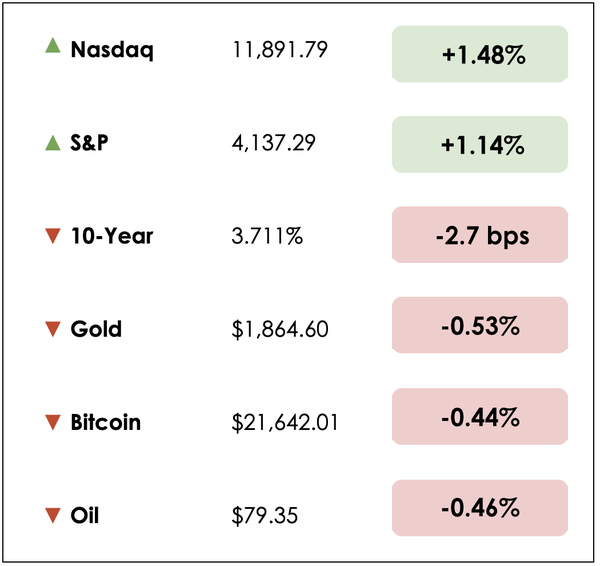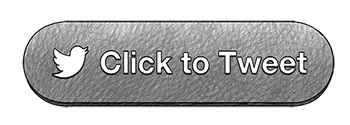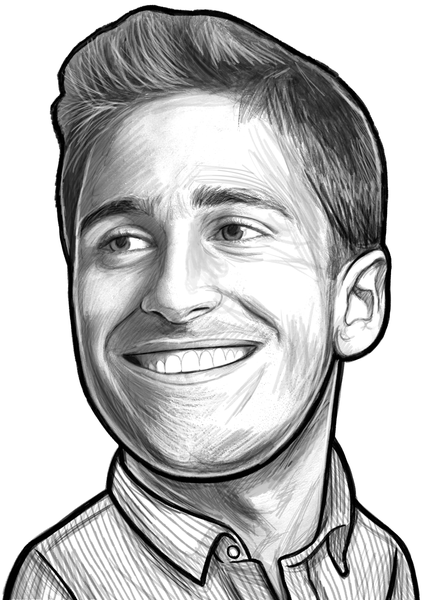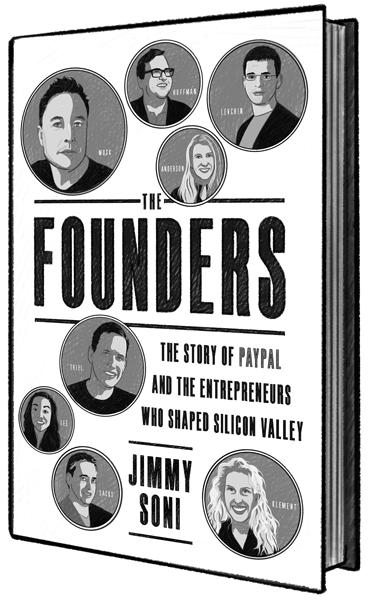Unicorn Incubator
13 February 2023

Hi, The Investor’s Podcast Network Community!
🛸 Investors seemed unfazed by the baffling surge in UFO activity recently, which prompted the U.S. military to shoot down floating objects (balloons?) using fighter jets three times in the past few days, in addition to the Chinese spy balloon shot down on February 4th.
Tensions are running hot, with the U.S. and China swapping accusations. The question remains whether these are just geopolitical espionage games or a fundamental shift in relations.
If you take your cues from financial markets, there’s seemingly little reason for concern as the Nasdaq Golden Dragon China Index rose over 2.5% today 🐉
Here’s the rundown:
MARKETS
*All prices as of market close at 4pm EST
Today, we’ll discuss two items in the news:
- New tax credits for energy projects
- Booming compensation at elite hedge funds
- Plus, our main story on the “PayPal Mafia”
All this, and more, in just 5 minutes to read.
Get smarter about valuing businesses in just a few minutes each week.
Get the weekly email that makes understanding intrinsic value
easy and enjoyable, for free.
IN THE NEWS
🔋 New Tax Credits for Energy Projects (WSJ)
Explained:
- The Treasury Department is planning to launch new tax credits for energy projects. These credits are intended to encourage investment in clean energy technologies, such as wind and solar power, and to reduce the nation’s reliance on fossil fuels.
- The details of the tax credits, including the amount and specific criteria for eligibility, have not yet been released.
- The new credits are part of the Biden administration’s larger plan to address climate change and transition to a more sustainable energy system.
Why it matters:
- The credits are earmarked for areas with high poverty rates, tribal land, low-income residential projects and places where low-income people will benefit. Officials plan to award priority to projects owned by community-based organizations and encourage new participants in markets.
- “These investments will create good-paying jobs in vital fields like clean energy manufacturing, critical minerals processing, and solar installation,” said Deputy Treasury Secretary Wally Adeyemo.
- The department said $1.6 billion of the first chunk of money would be reserved for places where coal mines or coal-fired power plants have closed. The Treasury Department said the government would begin taking applications on May 31st for the first $4 billion of the advanced energy program, which is a 30% investment tax credit.
💰 The World of Elite Hedge Funds (NYT)
Explained:
- Many in America are facing layoffs. Others are grappling with high inflation. But a tiny fraction of Wall Street is being promised hefty paydays.
- In the world of elite hedge funds, risky bets using esoteric number-crunching and cutthroat strategies have produced gigantic profits.
- Last year, Citadel, a hedge fund run by Kenneth C. Griffin, made $16 billion, the largest annual gain for a firm of its ilk, according to LCH Investments. Citadel and other industry behemoths like Millennium Management, Balyasny Asset Management, and Steve Cohen’s Point72 are courting potential hires by dangling tens of millions in guaranteed pay over several years, people with knowledge of the negotiations told The NYT.
Why it matters:
- “You’re seeing Tom Brady-like pay packages,” said Colin Lancaster, a former Citadel executive working at Schonfeld Strategic Advisors, another hedge fund that is competing to hire top traders. (Before he retired, Brady made $25 million per year, plus millions more in endorsements.)
- Hedge funds often use various strategies to minimize, or “hedge,” financial risk. Traders who can build complex and successful trading strategies tied to interest rates, stocks, commodities, currencies, and other assets can make nine figures annually because they’re typically paid a percentage of the profits they earn for investors in the fund.
- What’s different now is that the biggest hedge funds are guaranteeing eye-popping compensation to traders before they even start. In the past, when firms have offered such guarantees, they usually stayed below $10 million.
- It’s an industry of wide performance discrepancies, though. The top 20 hedge fund managers made $22.4 billion for their investors in 2022, excluding fees, according to a report from LCH Investments. The entire industry, however, lost $208 billion in 2022.
WHAT ELSE WE’RE INTO
📺 WATCH: The little-known committee that determines when a recession has begun 👂 LISTEN: How to optimize your portfolio for financial independence and sleeping well at night, with Cullen Roche 📖 READ: Regulators order Binance to stop issuing its stablecoin & more than half of Twitter’s top advertisers drop off the platform
Unicorn incubator
What do Elon Musk, the founders of Palantir, LinkedIn, Affirm, and Yammer (including the likes of Peter Thiel, Reid Hoffman, Max Levchin, and David Sacks, respectively) all have in common?
Riches? Yes. Innovation and entrepreneurship? Yes. But more interestingly, this elite bunch all got their start with PayPal, forming what some call the “PayPal Mafia.”
In his book, The Founders: The Story of PayPal and the Entrepreneurs Who Shaped Silicon Valley, Jimmy Soni interviews each of these billionaires and uses years of research to put their incredible stories together.
He likens this squad of tech titans to The Avengers or the 1990s Chicago Bulls. Beyond the big names, other important early PayPal alumni include the CEO of ancestry.com, senior leaders in government and Facebook, and the founder of the social enterprise kiva.org.
Breaking it down
Soni asked himself, “why hadn’t anyone gone back and tried to excavate this 20-year-old story?” dating back to the peak of the early 2000s dot-com bubble.
Soni left no stone unturned, from interviewing board members to customer service agents at the company to scouring the internet for past articles and even C-SPAN recordings. Each of his 275 unique conversations fostered new insights into PayPal’s early culture.
What to know
His book begins with Max Levchin, founder and CEO of fintech giant Affirm, who came to the U.S. as a Jewish refugee from the Soviet Union, where he had previously fallen in love with computers.
Studying at the University of Illinois Champaign-Urbana, he found inspiration from Marc Andreessen’s successes, who found fame after building the Mosaic browser and Netscape.
Soni describes Levchin as having a “near photographic memory,” with a deep interest in cryptography and mobile security, forming the basis of what would later become mobile payments. Some even say, “The Story of PayPal properly told is the story of Max Levchin.”
The genesis story
After a few failed startups, Levchin ventured to Palo Alto and linked up with an unknown young investor: Peter Thiel.
This isn’t a normal friendship, though; these two are super geniuses. Soni says they would “try to best each other with puzzles” and were “ace chess players.” They turned “math into sport.”
They were obsessed with learning and logic challenges. But Thiel had something of a quarter-life crisis at 25 after being turned down for a Supreme Court clerkship.
He made a dramatic pivot to global macro investing, moving back to California and developing an obsession with the internet gold rush.
Thiel began teaching a class on currency trading at Stanford, where he stumbled into Levchin, who sat in on his class to find reprieve from the scorching heat outside.
After later meeting for breakfast, the two formed what Soni calls one of the most interesting relationships “in the history of American business.”
PayPal’s first iteration
They were both wildly smart but in different ways. They complemented each other’s skill sets while challenging each other intellectually. Shortly thereafter, Thiel invested in Levchin with a $100,000 loan, thus forming the earliest iteration of PayPal.
Thiel would later become the first outside investor in Facebook, in addition to founding multi-billion dollar data analytics firm Palantir. Lesser known was his role in bankrupting Gawker via one of the most consequential yet strange lawsuits in American media history.
Musk joins the picture
Next enters Elon Musk in the PayPal Mafia saga, who had successes that predated PayPal. With his brother, they formed Zip2, which provided online city guide software to newspapers. They sold it to Compact Computer for over $300 million.
Rather than riding out his days on an island beach, Musk’s appetite for groundbreaking startup successes had just begun.
In a time of dial-up modems, Musk envisioned how the internet could revolutionize finance. With his Zip2 money, Musk pours funds into X dot com, attracting key hires with his considerable skin in the game. He “burned the boats” by betting nearly his entire fortune, and others took notice, inspired by his commitment.
Musk’s company, which aimed to provide insurance, mortgages, lines of credit, savings accounts, brokerage accounts, and everything in between, would then merge with Thiel’s firm, Confinity, to form what we now consider to be PayPal in a “shotgun wedding.”
The rivalry that made PayPal
Confinity and X dot com gained traction on the emerging platform eBay.
At the same time, they both offered generous bonuses to those who joined their respective services in a fight over market share until ultimately realizing they would spend themselves into oblivion.
They begrudgingly merged, but not without “a lot of drama and tension,” said Soni.
The story twists and turns on, making for a truly compelling read that provides unparalleled insights into what it was like at this world-changing company, headed by entrepreneurial juggernauts, at the height of the internet revolution.
Dive Deeper
To read the full story, you can purchase Soni’s book here. You can also listen to an abbreviated version of the story in his interview with Trey Lockerbie.
SEE YOU NEXT TIME!
That’s it for today on We Study Markets!
See you later!
If you enjoyed the newsletter, keep an eye on your inbox for them on weekdays around 6pm EST, and if you have any feedback or topics you’d like us to discuss, simply respond to this email.











